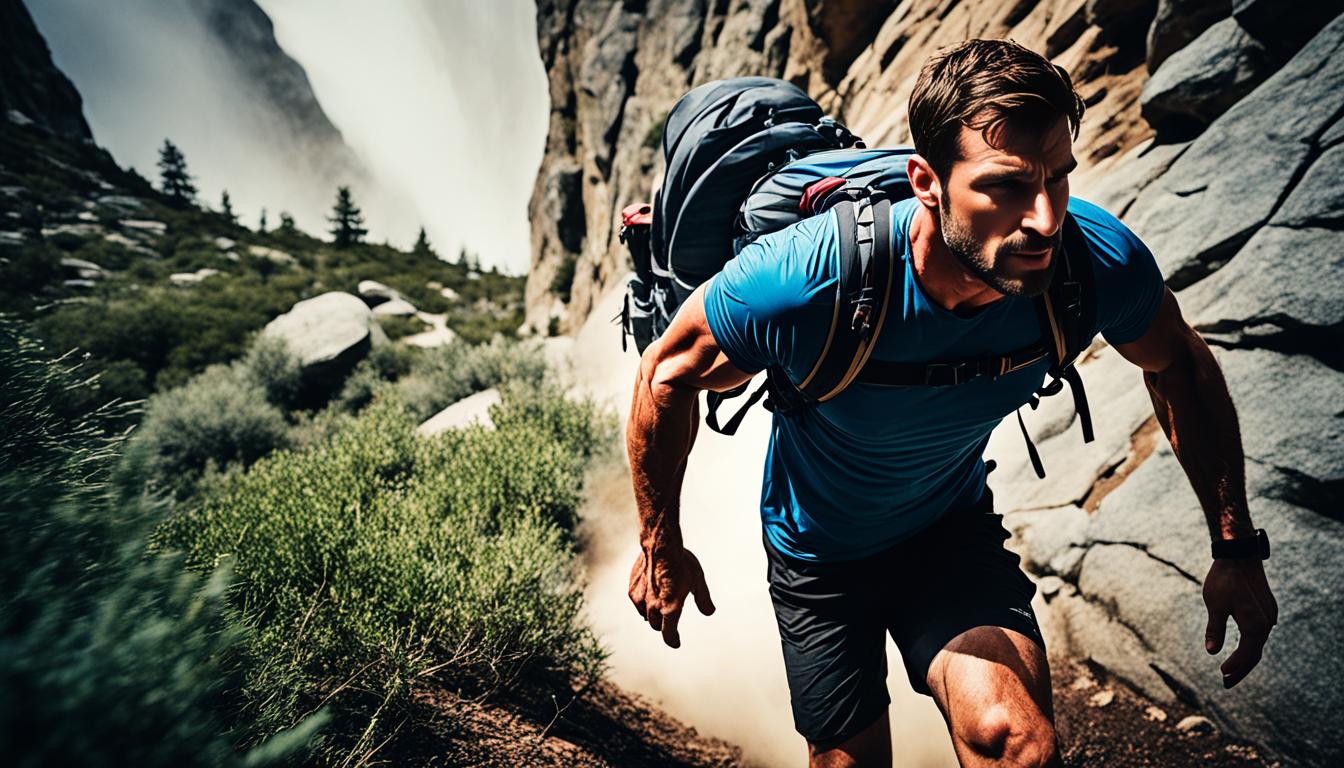If you love hiking, you might know the pain of delayed onset muscle soreness (DOMS) after a tough hike. A big 60% of hikers face this issue, especially on steep trails like the 1.5-mile Skyline Trail. This trail has a big 1,800 feet of elevation gain near Mile 61 of the Sterling Highway.
Dawn Bragg, a hiker, shared her experience with post-hike muscle pain. “After my first hike of the season, I felt really sore, especially going down steep hills,” she said. “It felt like my muscles were doing two things at once, causing tiny tears that made me sore.”
Key Takeaways
- Steep hiking trails can cause significant muscle soreness known as delayed onset muscle soreness (DOMS)
- DOMS is caused by eccentric muscle contractions that lead to microscopic tears in the muscle fibers
- Proper preparation, gear selection, and post-hike recovery techniques can help alleviate DOMS
- Strengthening the glutes, a key muscle group for hiking, can also reduce the risk of DOMS
- Incorporating regular stretching, massage, and hydration into your hiking routine can help manage muscle soreness
Understanding Delayed Onset Muscle Soreness (DOMS)
Delayed Onset Muscle Soreness (DOMS) is a common issue after new or intense physical activity, like hiking steep trails. It starts around 8 hours post-exercise and peaks in 24-48 hours. Then, it slowly gets better.
What is DOMS?
DOMS happens when tiny tears form in muscle fibers from new or harder workouts. This damage causes inflammation, leading to soreness and stiffness.
Signs of Normal and Abnormal DOMS
Some muscle soreness and stiffness are normal during DOMS. But, you should still be able to do your daily tasks, even if it’s a bit harder. If you see signs like these, it might be more serious DOMS:
- Pain during or right after exercise
- Pain that doesn’t go away in a few days
- Can’t do normal daily tasks because of muscle pain
If you see these signs, talk to a healthcare professional. They can check for any serious issues and help you get better.
Causes of DOMS After Hiking
Delayed Onset Muscle Soreness (DOMS) is common among hikers, especially if you’re new or upping your hike game. It happens when you start a new exercise, add a new activity, increase training intensity, or repeat exercises a lot.
Starting a new activity like hiking puts a lot of stress on your muscles. This can cause tiny tears in the muscle fibers. These tears lead to inflammation and the pain and stiffness of DOMS. If you’ve taken a break from hiking and then hike more intensely, your muscles might not be ready, causing DOMS.
Repeating movements like climbing and descending hills can also lead to DOMS. These actions cause micro-tears in muscle fibers. This results in soreness and stiffness a day or two after a tough hike.
DOMS is a normal reaction to new or intense physical activity. Knowing why it happens helps you prepare and manage the discomfort. This way, you can keep enjoying your hikes.

Is DOMS a Healthy Sign?
DOMS, or delayed onset muscle soreness, is often seen as a good sign for your fitness journey. It’s the muscle aches and pains that start 24-48 hours after a tough workout. These pains come from tiny tears in the muscle fibers. These tears are a natural part of making your muscles grow and repair.
Benefits of DOMS
Even though DOMS isn’t fun, it means your body is doing something great. As your muscles heal and get stronger, you’ll see many benefits:
- Increased muscle size and strength – The repair process adds new muscle fibers, making your muscles bigger and stronger.
- Improved exercise recovery – DOMS shows your body is getting better at recovering from your workouts.
- Enhanced muscle growth and repair – DOMS means your muscles are growing and repairing naturally, which is key for building muscle mass.
So, when you feel DOMS after a tough hike or workout, see it as a sign your body is getting stronger. Supporting your body’s healing helps you get the most out of DOMS and reach your fitness goals.
Sore But Muscles When Steep Hiking Trails
Hiking lovers often feel sore in their calves and thighs after going up steep trails and stairs. This is called delayed onset muscle soreness (DOMS). It’s a normal reaction to the hard work of hiking outdoors.
For beginners or those coming back to hiking, the soreness can be really tough. It makes even simple actions hard. The steep hills and rough paths put a lot of strain on the muscles. This leads to tiny tears and swelling, causing the soreness we feel.
Even though DOMS is uncomfortable, it means your muscles are getting used to the activity. The soreness usually gets worse 24-48 hours after the hike and can last for days. But, it’s key to know the difference between normal soreness and a serious injury that needs a doctor.
“The pain of hiking a steep trail is often a rite of passage for outdoor enthusiasts, a badge of honor that signifies the dedication and resilience required to conquer nature’s challenges.”
To help with sore muscles after hiking, it’s important to follow a recovery plan. This includes gentle exercises, stretching, and staying hydrated and well-fed. Taking good care of your body helps make the soreness go away faster. This way, you can get stronger, last longer on hikes, and enjoy nature more.

Easing DOMS with Home Remedies
After a tough hike, you might feel muscle soreness, known as DOMS. This pain is normal and can be lessened with home remedies. These remedies help with pain and speed up recovery.
Move and Stretch
Moving and stretching your muscles helps with blood flow. This flow removes waste and brings nutrients for healing. Try walking or yoga to help your muscles recover.
Massage and Foam Rolling
Massage or foam rolling can ease DOMS. It boosts blood flow and reduces swelling, helping muscles heal faster.
Cold and Heat Therapy
Cold therapy, like ice packs, reduces inflammation and dulls pain right after exercise. Then, switch to warm heat, such as a heating pad, to improve blood flow and aid recovery.
Protein-Rich Diet
Eating a diet full of protein helps muscles repair and grow. Include lean meats, fish, eggs, or plant-based proteins in your meals after hiking.
Stay Hydrated
Drinking enough water is key for recovery. Dehydration slows down healing. Drink water before, during, and after your hike to keep muscles working well.
Get Enough Sleep
Good sleep lets your body fix muscle tissue. Aim for 7-8 hours of sleep each night to help your body recover and lessen DOMS symptoms.
Using these home remedies after your hike can make you feel better and recover faster. This lets you hit the trails again sooner.
The Importance of Glutes in Hiking
The glute muscles are key for hiking. They help power your movements and keep you stable. The gluteal region includes the gluteus maximus, gluteus medius, and gluteus minimus. Together, they make hiking efficient and safe.
Gluteus Maximus: The Powerhouse
The gluteus maximus is the biggest and strongest glute muscle. It helps you move uphill by extending your hips. A strong gluteus maximus keeps your posture right and protects your lower back, knees, and ankles from strain.
Gluteus Medius and Minimus: Stability Muscles
The gluteus medius and gluteus minimus keep your hips aligned and balance your body on rough ground. They control hip abduction and rotation. This helps prevent knee pain, ankle instability, and muscle imbalances while hiking.
Strengthening your glute muscles boosts your hiking performance and lowers injury risk. By focusing on these muscles, you’ll get more power, stability, and a better hiking experience.
“Hiking is an excellent way to target and strengthen the glute muscles, but it’s important to ensure that these muscles are properly activated and engaged throughout the activity.”
Strengthening and Activating Glutes
Before and during your hikes, focus on exercises that strengthen your glute muscles. These muscles are key for good movement and preventing injuries on steep trails.
Use exercises like squats, lunges, and glute bridges to work on the gluteus maximus, medius, and minimus. These exercises build strength and make sure you use your glutes during hikes.
Also, engage your glute muscles by pressing on the area or doing a few squats or lunges before you start hiking. This helps your brain remember to use your glutes, which improves your hiking and lowers injury risk.
| Exercise | Sets | Reps | Purpose |
|---|---|---|---|
| Squats | 3 | 10-12 | Strengthen glutes, quads, and hamstrings |
| Lunges | 3 | 10-12 per leg | Engage glutes and improve balance |
| Glute Bridges | 2 | 15-20 | Isolate and activate the glutes |
Focus on glute strengthening exercises and glute activation to get your body ready for hiking. This helps prevent muscle imbalances and hiking injuries. Spend time on these areas, and you’ll be ready for any trail.
Conclusion
This article has covered the causes, signs, and ways to deal with Delayed Onset Muscle Soreness (DOMS) after hiking, especially on steep trails. It stressed how important the gluteal muscles are for hiking and preventing injuries. It also gave tips on how to strengthen and activate these muscles.
By using home remedies and strategies, like active recovery, massage, foam rolling, and eating a lot of protein, hikers can lessen DOMS. This makes their outdoor adventures more enjoyable and lowers the chance of getting hurt. The article also talked about how DOMS can make muscles grow stronger and how important it is to prepare for hiking right.
It mentioned the need for glute exercises and using the right gear like hiking poles and backpacks. Overall, this article aims to help hikers understand and handle muscle soreness after tough hikes. It ensures they can keep enjoying the health benefits of being outdoors and doing this great activity.
FAQ
What is Delayed Onset Muscle Soreness (DOMS)?
DOMS is a common response to new or intense exercise. It causes muscle pain and stiffness. This usually peaks 24-48 hours after the activity.
What are the signs of normal and abnormal DOMS?
Normal DOMS starts around 8 hours after exercise and doesn’t stop you from doing daily tasks. But, abnormal DOMS causes pain during or right after exercise. It also lasts more than a few days and makes daily tasks hard.
What causes DOMS after hiking?
DOMS after hiking can come from being new to exercise or adding a new activity. It can also happen if you increase your training intensity or do the same exercise too often.
Is DOMS a healthy sign?
Yes, DOMS is seen as a healthy sign. It means tiny tears in muscle fibers, which heal quickly. This healing makes muscles bigger and stronger.
How can I ease the symptoms of DOMS?
To ease DOMS symptoms, try moving and stretching. Massage and foam rolling also help. Cold and heat therapy, a protein-rich diet, staying hydrated, and good sleep are also key.
Why are the gluteal muscles important for hiking?
The gluteal muscles are key for hiking. They help with hip extension, stability, and force transmission. This is crucial for hiking performance and preventing injuries.
How can I strengthen and activate my glute muscles for hiking?
Strengthen your glutes with exercises like squats, lunges, and glute bridges. Also, make sure to engage your glutes before and during hikes to boost muscle activation and performance.
















